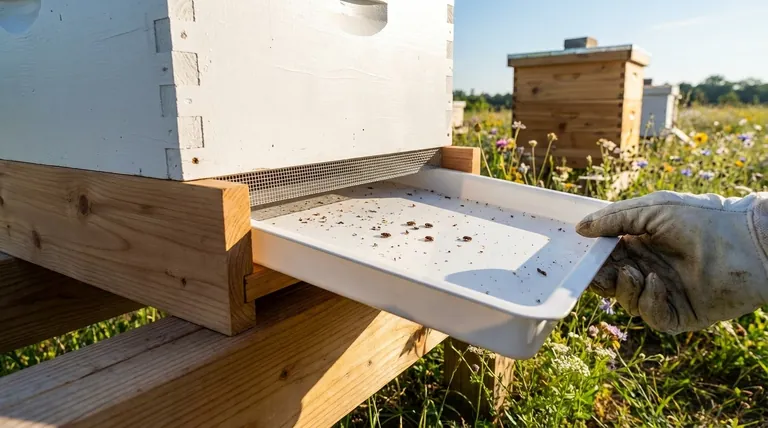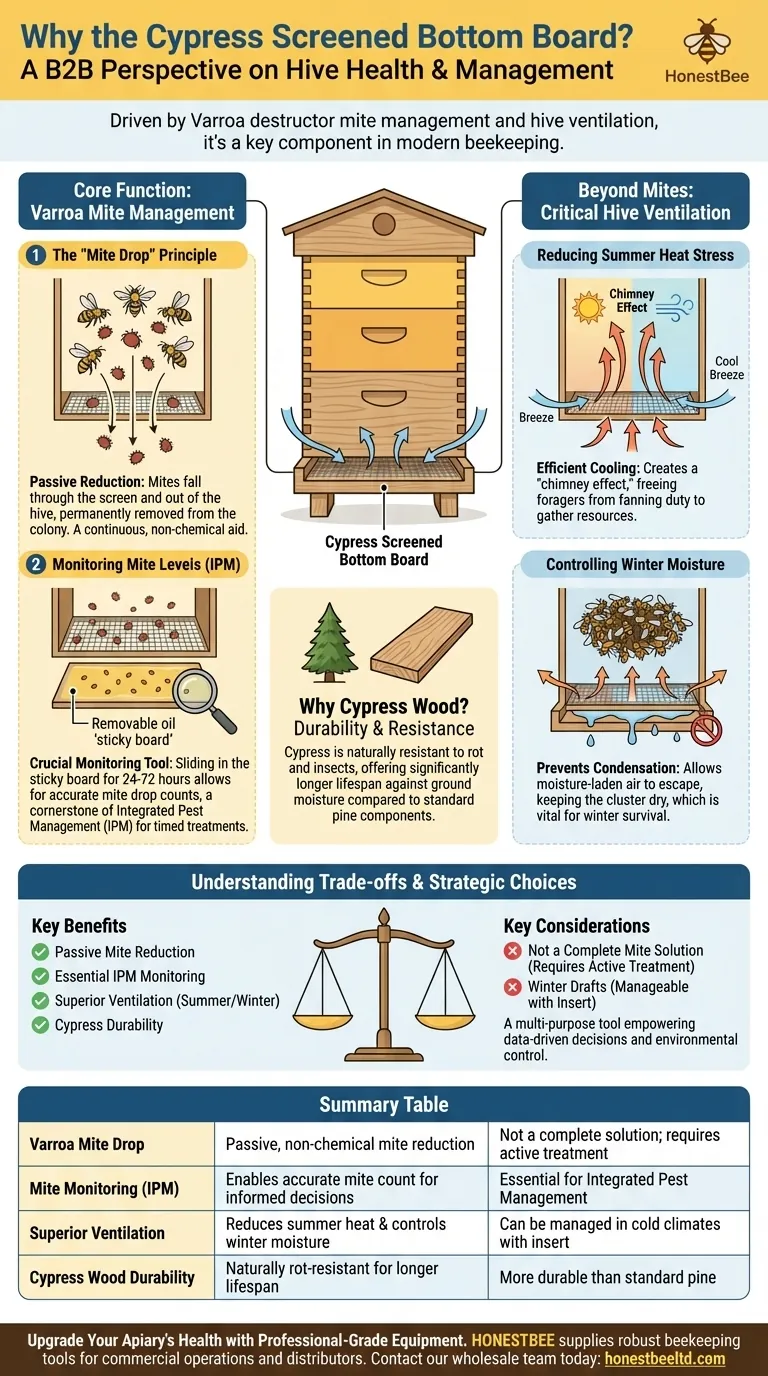The primary driver behind the popularity of the Cypress Screened Bottom Board is its role as a key tool in managing Varroa destructor mites, the single greatest threat to modern honey bee colonies. Its inclusion in most beekeeping starter kits reflects its status as a widely accepted component for promoting hive health.
While often promoted solely for mite control, the screened bottom board's true value lies in its dual function as a passive pest management device and a critical hive ventilation system. Understanding its limitations, however, is just as important as appreciating its benefits.

The Core Function: Varroa Mite Management
The fight against the varroa mite has fundamentally reshaped modern beekeeping. The screened bottom board is a direct response to this challenge, offering a simple, non-chemical method to aid in this fight.
The "Mite Drop" Principle
Varroa mites occasionally lose their grip and fall from their honey bee hosts. In a hive with a traditional solid bottom board, the mite can simply wait and climb aboard the next passing bee.
A screened bottom board breaks this cycle. When a mite falls, it passes through the #8 hardware cloth screen and out of the hive, permanently removing it from the colony. While this only affects a fraction of the total mite population, it provides a constant, passive reduction in mite load.
Monitoring Mite Levels (IPM)
Perhaps its most important function is as a monitoring tool. Most screened bottom boards come with a removable solid insert, often called a "sticky board" when coated with oil or shortening.
By sliding this board in for a 24-72 hour period, beekeepers can conduct a "mite drop count." Counting the mites that have fallen onto the board gives a reliable estimate of the infestation level within the hive, which is a cornerstone of Integrated Pest Management (IPM). This data tells you when and if more aggressive mite treatments are necessary.
Why Cypress Wood?
The use of cypress is a feature focused on durability. The bottom board is the hive component most exposed to ground moisture, dampness, and decay. Cypress is a wood known for its natural resistance to rot and insects, giving it a significantly longer lifespan than pine, the standard wood for most other hive components.
Beyond Mites: The Benefit of Ventilation
While introduced for mite control, many beekeepers now value the screened bottom board primarily for its ventilation properties, which provides year-round advantages.
Reducing Summer Heat Stress
On hot days, a significant portion of the colony's energy is spent fetching water and fanning to evaporate it, which cools the hive and maintains the brood nest at a stable temperature. A screened bottom provides a large opening for air exchange, creating a "chimney effect" that greatly improves airflow. This reduces the colony's workload, freeing up foragers to gather nectar and pollen instead of water.
Controlling Winter Moisture
A wintering cluster of bees consumes honey and generates a surprising amount of heat and water vapor. In a hive with a solid bottom, this warm, moist air rises, hits the cold inner cover, and condenses—often dripping back down as cold water onto the bees.
A wet bee is a dead bee. The screened bottom allows this moisture-laden air to escape the hive, keeping the cluster dry. For overwintering success, being dry is often more critical than being warm.
Understanding the Trade-offs
No piece of equipment is without its downsides. Objectively evaluating the screened bottom board means acknowledging the debates and potential issues.
The Wintering Debate: "Is It Too Cold?"
The most common concern is that a screen will create a draft and make the hive too cold in winter. However, bees heat their cluster, not the entire hive cavity. As long as the cluster is dry and has access to food, it can thermoregulate effectively even in very low temperatures.
In extremely cold or windy locations, many beekeepers slide the solid insert board back in, leaving a small gap at the front for ventilation. This blocks direct wind while still allowing moisture to escape.
It Is Not a Complete Mite Solution
This is the most critical point of understanding. A screened bottom board is a passive tool, not an active treatment. It will not, on its own, save a colony from a serious varroa mite infestation.
It is one small part of a comprehensive IPM strategy. Relying on it as your sole method of mite control will almost certainly lead to colony failure. Its primary role is in monitoring and providing a slight reduction in mite numbers.
Making the Right Choice for Your Hives
A screened bottom board is a strategic choice, not just a default piece of wood. How you leverage it depends on your beekeeping goals and climate.
- If your primary focus is Integrated Pest Management (IPM): The board is an essential monitoring tool for conducting accurate mite counts to inform your treatment decisions.
- If your primary focus is maximizing colony health with low intervention: The passive mite reduction and superior year-round ventilation make it a clear upgrade over a solid board.
- If you are beekeeping in a damp or moderate-winter climate: The moisture control benefits for overwintering are arguably its most valuable feature.
- If you are in an extremely cold and windy region: You can still benefit from the screen, but plan to use the insert to block severe wind drafts during the coldest months.
Ultimately, the screened bottom board is a multi-purpose tool that empowers you with more data and better environmental control for your colonies.
Summary Table:
| Key Feature | Primary Benefit | Key Consideration |
|---|---|---|
| Varroa Mite Drop | Passive, non-chemical mite reduction | Not a complete mite solution; requires active treatment |
| Mite Monitoring (IPM) | Enables accurate mite count for informed treatment decisions | Essential for Integrated Pest Management strategies |
| Superior Ventilation | Reduces summer heat stress & controls winter moisture | Can be managed in cold climates with insert board |
| Cypress Wood Durability | Naturally rot-resistant for longer lifespan in damp conditions | More durable than standard pine components |
Upgrade Your Apiary's Health with Professional-Grade Equipment
Are you a commercial apiary or beekeeping equipment distributor looking to enhance your hive management with reliable, durable tools? The Cypress Screened Bottom Board is just one example of the high-performance equipment that can make a difference in your operation.
HONESTBEE specializes in supplying robust beekeeping supplies and equipment through our wholesale-focused operations. We provide the tools commercial beekeepers and distributors need to implement effective IPM strategies and maintain optimal hive health year-round.
Let us help you equip your operation for success. Contact our wholesale team today to discuss your specific needs and discover how our products can contribute to your bottom line.
Visual Guide

Related Products
- Australian Pine Wood Langstroth Screen Bottom Board for Wholesale
- Langstroth Screen Bottom Board for Beekeeping Wholesale
- HONESTBEE Wooden Bee Escape Board with Triangle Mesh Design for Beekeeping
- Professional Galvanized Hive Strap with Secure Locking Buckle for Beekeeping
- Mesh Ventilated 3 Layer Goatskin Beekeepers Gloves for Beekeeping
People Also Ask
- Are screened bottom boards necessary for beekeeping? A Strategic Choice for Modern Hive Health
- What are the steps to install wire mesh as a floor in a beehive? A Guide to Better Ventilation & Mite Control
- Why do some beekeepers switch between screened and solid bottom boards? Optimize Your Hive's Health Year-Round
- How does a screened bottom board benefit the hive during the summer? Boost Ventilation & Pest Control
- What features does the screened bottom board with insert offer? Essential Tools for Hive Health and Pest Control



















